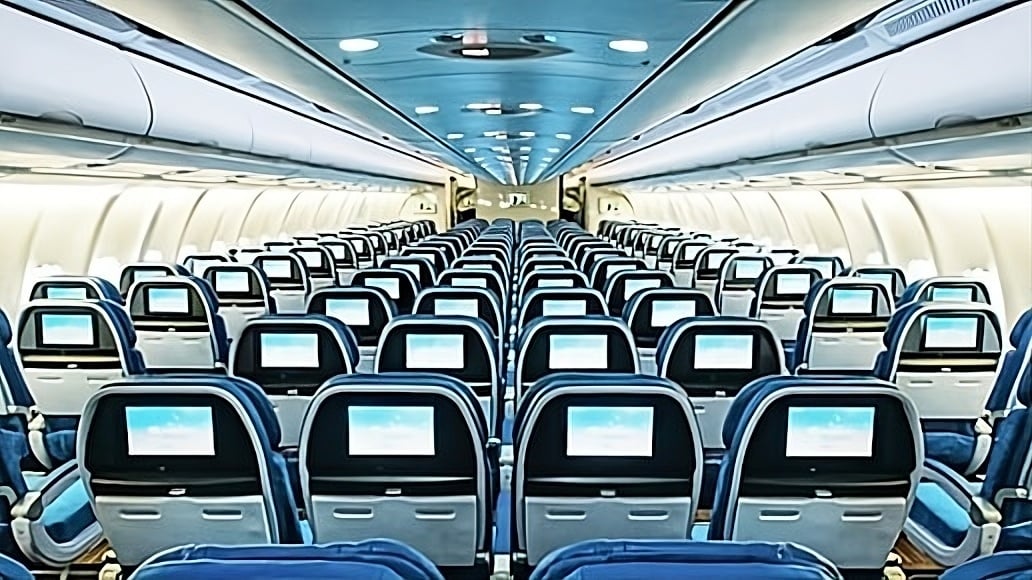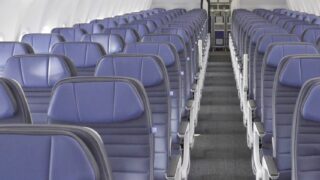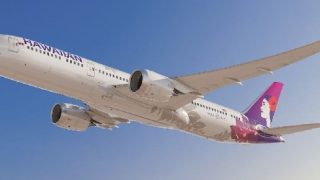You probably do not think much about the seatback screen until you settle in, get out your headphones, and watch the map trace that long arc over the Pacific. It’s all part of what once made flying to Hawaii feel special. But it’s slowly vanishing from more planes, and travelers are only starting to notice.
United and Delta are moving in the opposite direction from others by keeping theirs. They are investing in larger, brighter seatback systems while also upgrading connectivity. United’s chief financial officer, Mike Leskinen, put it plainly: “Those screens, along with high bandwidth Wi-Fi, make our customers’ journey infinitely better. We are not just adding a screen to a seat—we are adding a reason for someone to book with United.”
Delta says it sees stress levels drop when passengers sit down and drop further the moment seatback entertainment turns on. It now powers the screens from boarding rather than waiting until after takeoff.
For both trend-setting airlines, the screen is not a gadget. It is part of how the flight feels, and they believe that feeling builds loyalty.
Alaska/Hawaiian has a “split screen” personality.
On the Hawaiian A321neo jets that handle more and more West Coast routes, there are no seatback screens. The cabin is built around power at the seat and streaming to your own device. On the A330 widebodies, every seat still features a Panasonic system with movies, TV, music, a moving map, and the familiar island-style interface.
Hawaiian’s 787 Dreamliners, now being rebranded under parent Alaska, continue that long-haul approach with improved, larger screens and a more modern layout. The result is two very different experiences, both wearing the same plumeria for now.
The purchase by Alaska adds pressure to choose a path for the combined carrier. Alaska’s fleet has been designed around personal devices, lighter cabins, and fewer embedded systems. That model works for short and medium flights up and down the West Coast, where a tablet can carry a trip.
The story is different on Hawaii routes that run five to ten hours. Personal devices with small screens are old news on a long flight. Chargers (which, for safety, must now be present with us in the cabin), cables, and adapters sprawl into a limited space. Parents juggle movies for two seats and a snack run, too. Older travelers, who still make up a large share of the Hawaii market, often prefer the simple tap-and-watch functionality of a legacy built-in system. The absence of a screen may seem minor until you feel how much extra work it adds.
Why screens still matter on long flights.
A screen in the seatback clearly changes the pace of a long flight. It reduces the logistics you manage for hours at a time. It is a stable place for content that does not depend entirely on connectivity. It lets families settle in without a tangle of electronics, and it gives solo travelers a way to drift in and out of a film or the moving map without having to manage a device. None of this is nostalgic. It is practical comfort that shows up on flights where time stretches.
Bluetooth connectivity has further enhanced those systems. Being able to pair noise-canceling headsets directly to the seatback screen eliminates cables and static jacks, while maintaining consistent sound quality through flight noise, turbulence, and seat movement. When it works correctly, it is the best of both worlds, modern tech paired with classic comfort.
Proof from airlines that studied it.
United and Delta did not make their decisions on instinct alone. Both carriers are deep researchers of passenger behavior and cabin experience. United now pairs its seatback entertainment with free Wi-Fi and content partnerships that make the system feel modern, not dated.
Travelers can connect their Bluetooth headsets directly to the screen and stream a growing lineup that includes Apple TV+ Originals and Spotify content with more than 450 hours of curated playlists, podcasts, and audiobooks, all available without using live bandwidth.
Delta’s next-generation Delta Sync platform takes a similar path. Its Thales-powered seatback screens also feature Bluetooth pairing for wireless headsets and smart TV–style personalization that lets travelers resume shows, view flight progress, and access trip information in real time. Delta says the experience is designed to make the journey feel calmer and more connected from the moment passengers sit down.
For both airlines, this evolution is not about adding gadgets; it is about how comfort, familiarity, and small touches of technology change the way people feel on board and how they remember the brand afterward.
Where Alaska and Hawaiian could take this next.
It will be a significant brand change for Alaska, no matter how it’s cut. The airline has not publicly announced how it plans to handle the transition, but we already know that the Dreamliners will be refurbished and the A330s are due for a complete retrofit. The A321s may follow, which would make sense if Alaska wants a single, unified look across the fleet. There is a lot for the company to manage here, and even more for travelers to notice once the work begins.
Under Alaska’s ownership, the combined brands will face choices. Keep a dual standard that preserves embedded entertainment on the long-haul fleet, or simplify the operation around a single personal-device model that removes screens everywhere.
One path suggests that not every route is the same, and not every traveler requires the same tools. The other path says uniformity and efficiency matter most. The first option respects the reality of long flights to Tokyo, Sydney, New York, Asia, and Europe. The second will save weight and maintenance but risks hollowing out one of Hawaiian’s remaining points of difference.
We must also be candid about timing. When other airlines are adding back one of those comforts because they believe it calms people and builds loyalty, it is hard to explain why other Hawaii flights should move in the opposite direction. The spreadsheet answer is lighter cabins and standardized parts. The traveler’s answer is that the hours feel longer and the trip feels less special.
What travelers should expect and watch for.
If you are flying a Hawaiian A321neo to or from the West Coast, plan on using your own device. Bring a charging cable, perhaps even a compact power brick that sits near your seat, and consider downloading content in advance. Those aircraft already feature Starlink Wi-Fi, which provides excellent connectivity for streaming and browsing, even without seatback screens.
If you are booked on an A330, enjoy the built-in entertainment system while it lasts. These aircraft also now offer Starlink service, giving travelers both strong Wi-Fi and embedded screens for the moment.
The 787 Dreamliners, however, currently have no Wi-Fi at all, which makes those onboard screens even more valuable on long routes. Families should make a simple plan for kids so that one adult is not playing tech support for most of the flight.
If seatback entertainment is important to you, check the aircraft type when booking and again before departure, as equipment swaps can occur.
Over the next twelve to eighteen months, keep a close eye on what Alaska does with this merged identity. If the combined carrier preserves screens on the A330 and 787, it signals that they see long-haul Hawaii routes as different beasts. If screens start vanishing from the widebody fleet, it means efficiency and standardization won. Travelers will feel that shift first and talk about it long before any press release arrives.
There is one more angle. Screens do not prevent airlines from offering robust Wi-Fi or modern content partnerships. United and Delta are proving you can have both. In that model, the screen is largely the canvas and the Wi-Fi connectivity is the conduit. Together, they reduce friction and make time pass more easily, exactly the kind of small upgrade that makes a better flight and a better memory for the Hawaii travel experience.
And speaking of connectivity: Alaska has announced that starting in 2026, it will begin outfitting its fleet with Starlink satellite Wi-Fi, with full deployment expected across all aircraft by 2027. Hawaiian’s early adoption on its A321neo and A330 fleets gives the combined airline a head start in that transition.
That means even if screens fade, the connectivity backbone may strengthen, offering travelers one more reason to keep an eye on how this evolution plays out.
The next time you board a Hawaiian A330 or one of the new 787s and the welcome screen flickers on, take a moment to notice how it changes the mood. It may be one of the last touches that still makes a Hawaii flight feel part of the vacation and not just transit.
Would you miss it or is your personal device all you need flying across the Pacific? Share what you prefer, how you manage long flights now, and whether the presence or absence of a screen changed your last Hawaii trip.
Get Breaking Hawaii Travel News







I’m getting to the point where I’m not interested in traveling anymore, just stay home on the farm.
If I do get the urge, it’d be to Incheon and Hawaiian will stop flying there next month. Hawaiian is disappearing for me.
American Airlines flagship still has seatback entertainment. I’m also able to use my earbuds to watch a movie. I still would be happy watching it off my iPhone than watching it on those old screens that they used to pull down between the aisles and gave you those horrible plastic earplugs that plugged into your armchair with two wobbly knobs.
I don’t miss the seatback screens. I either use my iPhone, an old junker iPad, or my laptop (all depends on the power plugs, or not, on the particular aircraft). On Sunday, I just flew a Hawaiian A330 from the Mainland and used my iPhone to stream my YouTube TV subscription so I could watch NFL and MLB games. The fact that Hawaiian has fast Starlink internet is a game changer for me. Love it.
Aloha BOH. I personally rely on seatback screens. My phone is too small to watch a movie, and bringing a separate, larger personal device is very inconvenient. Our trips from the east coast are long so we travel as light as possible. One more electronic device added to our carry on bag or personal item is a no go for me. Mahalo for keeping us informed.
I agree about a small phone. We have I-phone 16e s, the smallest model.
Not going to lug around big phones, or I-pads just for travel entertainment.
Many years ago, I traveled all the way around the world with only a carry-on backpack. Screens were on every flight then.
We only take full-sized suitcases when we are going on a cruise, and I expect airlines to provide seatback screens in exchange for my money.
My first choice is Hawaiian, but I am becoming flexible, and not as anxious to travel as I used to be. Living in Maui makes traveling less important.
Aloha,
I guess I will be flying United and Delta. I hate having to deal with tech when I go on vacation. My husband is not tech savvy and so cannot have any entertainment except reading. I love the back seat screens, so much easier for older folks and parents with children. A six hour flight feels eternal when I have to look at a tiny screen the whole way. Kudos to United and Delta for knowing what their customers want. We are not all tech wizards, nor do we want to be.
Mahalo
I just flew on an A321, it was my first time, and missed the map and the screen so much. I agree with United and Delta, it way improves the experience except on super short hops which Hawaii is not.
We enjoyed the seatback screens going to New Zealand and back from Australia. Also, from Denver to Maui (A-330). Most of my recent flights have been to the West Coast: Portland; Seattle; San Francisco; Los Angeles and Las Vegas.
I appreciate the Starlink Internet but miss the seatback screens. The Only reason I haven’t started flying with another airline is because I can still fly directly to and from Maui without a stopover. If another airline begins offering direct flights, then for us, it will come down to who has a screen.
Interesting take. It really shows how small tech decisions tell a bigger story about different airlines priorities. Comfort or cost?
As a parent, the screen is one of the main reasons my kids survive the flight from Seattle to Honolulu. Please keep them!
If the Wi-Fi is solid and free, I don’t need the screen so much. My own tablet has what I want so I come prepared. If there’s a nice IFE however, I’ll gladly take it. Clearly the two big boys are thinking the same way. Alaska we don’t know.
Not surprised Alaska wants to standardize everything. But for 10 hours over the ocean, I’d rather not babysit my phone battery. Hope they don’t go that way.
Aloha~. Did I miss something, has a carrier announced that they’re pulling their seat back entertainment systems. Seems that it’s the status quo so I’m not sure how Hawaiian travelers are losing in flight entertainment. My opinion, if you have either high-speed Wi-Fi or seat back entertainment systems it’s a good flight!